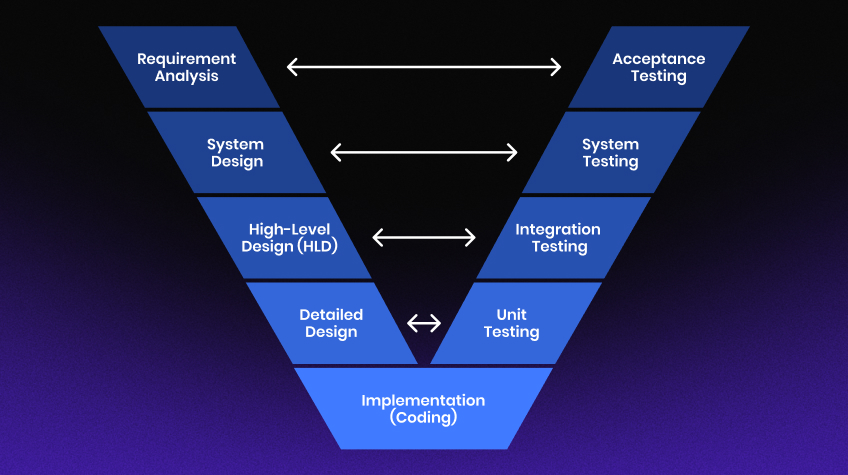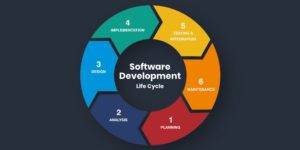
The V Model for software development is a lifecycle model that highlights the relationship between each stage of development and its matching testing phase. From requirements collection and analysis to design, implementation, testing, and maintenance, it takes a step-by-step approach. This model assists a software development company in guaranteeing quality and minimizing risks throughout the development process if applied in this structured pattern. In this guide, we will explore the V model, how it works, and V model requirements in software development.
What is a V-Model?
This development and testing model is commonly known as the V-Model in software development or the Validation Model. There is a testing phase for every stage of the development cycle, from requirements to code, guaranteeing that validation and verification are carried out early and consistently.
Shaped like the letter “V,” it means that the entire process is carried out with special attention to the stages it is subdivided into to ensure that the majority of problems that may appear in the course of the project are detected and eliminated at the initial phase when they are the easiest to solve and is most effective for the projects with clear requirements that are not expected to change much.
V Model Requirements in Software Development
The V-Model (Verification and Validation Model) is ideal to document tangible requirements at every stage of the software development, and thus pair every phase of development with a corresponding testing phase. Below are the key requirements for each stage in the V-Model:
1. Requirement Analysis
Requirements Analysis is the first phase in software development, where a team establishes, identifies, and records customers’ expectations and needs. The first and foremost aim is to define what the software has to deliver or do, which creates a foundation for other phases in the software development life cycle.
Key elements of Requirements Analysis:
- Requirements Gathering
- Requirements Documentation
- Requirements Analysis and Validation
- Prioritization and Scope Definition
- Requirements Review
- Creation of a Requirements Baseline
2. System Design
System design in the V-model converts the requirements that are identified during the Requirements Gathering and Analysis phase into a broad structure of the software. It means the identification of system scope, main elements or subsystems, their interactions, and data exchange.
- Objective: Make effective use of requirements at a coarse-grained level of representation such as conceptual architecture.
- Verification Activities: Review architecture to make sure it fulfills requirements and that it can be implemented.
3. High-Level Design (HLD)
High-Level Design (HLD) in V-Model establishes client applications and layouts up to the top level of each module, specifying the work of individual elements, their interconnections, and interfaces.
- Objective: Divide the system design into functionally distinct modules.
- Verification Activities: Perform HLD reviews to check developmental conformity to system design.
4. Detailed Design
In the V-Model software development, the Detailed Design phase is a documentation of what happens internally within each of the modules thus the prerequisites including the formulas, the structures, the properties, and values among other things, to be designed. They divide abstract parts into specific stages, allowing developers to introduce specific features.
- Objective: It is recommended that a detailed design for every module including algorithm and data structure should be developed.
- Verification Activities: Submissions by peers to make sure that particular designs are elaborate to address specific characteristics.
5. Implementation (Coding)
The implementation (Coding) phase in the V model is one in which developers take on the responsibility of translating the detailed designs into actual programs. End-user modules are to be coded following certain stipulations based on optimality, especially precision, speed, and conformance to industry benchmarks.
- Objective: Implement the specifics of the designs onto code.
- Verification Activities: Testing of the code and spells of analyzing to ensure that the actual code was developed according to the designs.
6. Unit Testing
In the V model unit testing comes at the most initial level and it mainly checks the functionality of modules or individual parts only after the code is written. Each is tested individually to verify that it meets the defined requirements of the detailed design.
- Objective: Confirm various unit operations of each element or component.
- Validation Activities: Make sure every module is running as planned in the detail presented when creating it.
7. Integration Testing
Integration Testing is concerned with testing the working of integrated modules or components. When individual modules pass through unit testing, they are integrated, and integration testing checks that data movement and the interactions of the modules are correct.
- Objective: Use the integrated modules in testing or demonstration of interactions.
- Validation Activities: Ensure that all the modules of your software application work as planned out from the high-level architectural design.
8. System Testing
In the V Model, System Testing means that the actual system has to be tested as a whole against the system requirement mentioned in the V-Model. This phase verifies the entire system’s ability to meet all functional and non-functional requirements, including its security and compliance.
- Purpose: Check whether the actual complete and integrated system of a given domain meets the system requirements.
- Validation Activities: It refers to a system that checks the performance of a software system in its functioning environment from one end to another.
9. Acceptance Testing
Acceptance Testing is the last stage where a system or software collectively undergoes a test by running the whole system based on the business and user requirements that have been set for the stakeholders. It is mainly done by the end users or the customer representatives within a real or virtual setting.
- Objective: Get an assessment of the final product by the customer or the end-user.
- Validation Activities: Verify with interested parties that the finished system satisfies all requirements.
Importance of the V Model in Software Engineering
The importance of the V-Model in software engineering includes:
- Early Detection of Defects: Verification and validation are implemented at every level, which assists in detecting a problem in the process.
- Structured Process: Another importance of the V Model in software development is that it offers a straightforward and methodical way of doing development and testing.
- Better Quality Assurance: Tests of functionality besides checking that all non-functional requirements are met only when testing is carried out continuously.
- Clear Documentation: Every phase is quite transparent, and that somewhat helps in achieving traceability and minimizing misunderstandings.
- Risk Mitigation: Testing at each phase reduces the risks in a project by addressing them in the initial phases of the project.
- Well-Suited for Stable Requirements: Most advantageous for project environments in which there is less likelihood of requiring changes in project requirements.
Also Read: Software Development Metrics to Track
How V Model Works in Software Development?
The V-Model works in software development as follows:
- Requirements Analysis: Identify the stakeholder needs and get them on record.
- System Design: Develop a system architecture from the requirements for a system.
- High-Level Design (HLD): The system can be epitomized in modules where each of them has a specific function.
- Detailed Design: Describe the internal properties of the program, the algorithms used, and the data structures for each of the modules.
- Implementation (Coding): The software code should be generated from the detailed design.
- Unit Testing: It checks the correctness and efficiency of individual modules.
- Integration Testing: Check communication between interconnected components.
- System Testing: This task involves validating the whole system regarding the system requirements.
- Acceptance Testing: Before the actual implementation of the system make sure it will fulfill the expectations and needs of the users.
Various Phases of Verification Phase of V-model
The V-Model’s “Verification Phase” verifies that the requirements established at the current level are met by the subsequent stages of development. The following are the stages of the verification process:
- Requirements Verification: All the software requirements must be properly specified, adequate, and realistic.
- System Design Verification: Ensure the architectures and designs that have been done are congruent with the set specifications.
- High-Level Design (HLD) Verification: Check for consistency and alignment with system design by reviewing and validating high-level design documentation.
- Detailed Design Verification: The detailed design should match the high-level design specification and complement it.
- Code Verification: Ensure that the code is managed in compliance with the design procedure.
Key Advantages and Disadvantages of the V Model in Software Development
The V-Model is most appropriate for projects that are of small to medium size and the requirements of which have been fully defined or where emphasis on managing risks and very systematic testing is important.
V Model in Software Development Advantages:
- Early Detection of Defects: Every step of validation and verification aids in the early detection of problems.
- Structured Testing Process: Testing procedures are planned and carried out concurrently with the stages of development.
- Clear Documentation: All the phases are well documented and this assists in overseeing and maintenance of the whole process.
V Model in Software Development Disadvantages:
- Rigid Structure: Not very flexible after getting into the requirements phase.
- Not Suitable for Complex or High-Risk Projects: It may not be appropriate where there is extensive prototype working or where flexibility is needed.
- Limited Flexibility: Modifications that occur halfway through may cause a cycle to go back to a previous stage and increase in time and cost.
Conclusion
To sum up, the V-Model is a sequential, phased approach to software development that focuses on timely and accurate requirements specification and means for systematic review and testing at all stages. Each of those requirements is then checked in parallel with the designing and testing phase of a given requirement to help a software development agency deliver better quality with a lower chance of errors in further stages.






